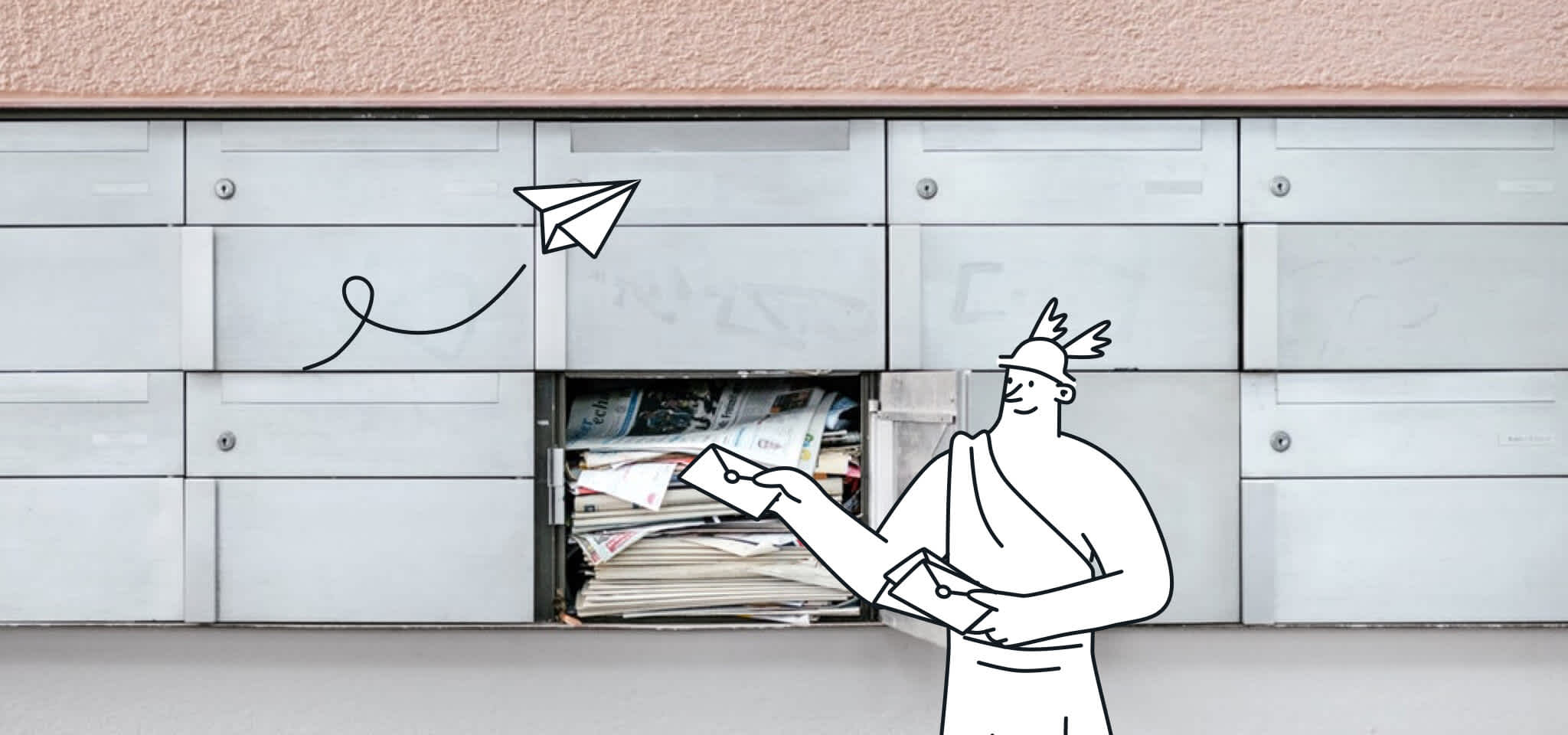Deliverability
All you need to know about transactional email
A well-built transactional email platform can be a game-changer that takes your online business to the next level and sets you apart from the pack.

PUBLISHED ON
Whether you're a small business, a non-profit, or a fast-growing startup, transactional emails play a critical role in shaping your customers' experience and perception.
All you have to do is look at the numbers: studies show 93% of people say they would consider giving up a brand because of a bad experience with a transactional email. That's why choosing the best transactional email service provider is essential for any successful ecommerce business.
When properly used, transactional email can be a powerful digital marketing tool to help grow your company and set you apart from the pack.
In this article, we’ll break down everything you need to know about effective transactional emails.
Table of content
01What is transactional email?
02What’s the difference between a transactional email and a marketing email?
03Types of transactional emails
04Benefits of transactional email
06Optimization: Making your transactional emails work overtime
07Don’t overdo it: Risks of using your transactional email strategy for marketing purposes
What is transactional email?
Transactional emails – or triggered emails – are emails sent to a single individual directly resulting from a particular action. They can include account creation emails, double opt-ins, order confirmations, password resets, purchase receipts, delivery notifications, customer support interactions, and countless more.
In short, if it's triggered by specific customer behavior, it's a transactional email.
What’s the difference between a transactional email and a marketing email?
Although they may appear similar, transactional emails differ from promotional emails because they serve a different purpose.
Marketing emails are used to promote products or services to a mass audience. They foster brand awareness, stimulate customer engagement, and ideally lead to increased sales. Marketing emails can include newsletters, product updates, announcements, and special offers, among many other types of emails.
On the other hand, transactional emails provide individual customers with specific, non-promotional information that relates only to them. So, it's no surprise that they come with their own set of distinct benefits.

Types of transactional emails
So now that you have a good understanding of what a transactional email is, and how it differs from a promotional email, let’s look at some of the most common examples of transactional emails:
Type of transactional email | Description |
|---|---|
Type of transactional email | |
Order confirmation | An order confirmation email is an automated message sent by a company to a customer after they've placed an order online. It typically thanks the customer for their purchase, summarizes the order details (items, quantities, prices), and provides estimated delivery timelines. |
Description | |
Shipping notification emails | Shipping notifications are a courtesy email sent by a company to inform a customer that their order has been shipped and is on its way. |
Password reset emails | After a user submits a password reset request a password reset email is triggered which usually includes a link or button to create a new login. |
Abandoned cart emails | An abandoned cart email is an automated message sent to customers who added items to their online shopping cart but didn't complete the purchase. It aims to remind them to return to the online store and complete the checkout process. |
Delivery confirmation emails | An automated email message sent by a shipper or retailer to inform a customer that their order has been delivered. |
Double opt-in email | A double opt-in email is a confirmation email sent after someone signs up for your email list. The recipient clicks a link in the email to verify their signup and officially become a subscriber. This extra step helps ensure you have an engaged subscriber base and reduces the number of fake addresses on your list. |
Benefits of transactional email
A solid marketing email platform is a pillar of any successful growth campaign, but that doesn't mean you should neglect your transactional email strategy. A well-built transactional email platform has a profound impact on the overall customer experience.
Here are some of the main benefits of transactional emails:
Personalization: Transactional email lets you personalize your content to specific customers using behavioral data.
Customer engagement: Personalization results in increased engagement with your content.
Build trust: Transactional emails can help build customers' confidence in your brand by providing critical information as and when they need it.
Timing: Setting up marketing automation and workflows means transactional emails can act as a real-time response to a specific action, leading to a better overall customer experience.
Marketing optimization: Transactional emails can also serve as an opportunity to promote related products or services based on your customers’ preferences.
Tracking: Transactional emails allow you to track metrics like opens, clicks, bounces, and blocks. Services like Mailjet can even give you webhook notifications in real-time.
Brand recognition: Whether it's a welcome email or a shipping confirmation, transactional email gives your brand added visibility.
Not only are there several benefits to transactional emails, but data from our recently published report, The path to email engagement 2024, showed that 74% of consumers in the U.S., UK, France, Germany, and Spain chose email as the preferred channel for receiving transactional messages from brands.

Getting to the inbox
All of which brings us to one of transactional email’s strengths: deliverability.
Transactional emails enjoy a significant advantage in terms of deliverability thanks to their high open rates and click-through engagement. According to some estimates, transactional emails receive between 80-85% open rates, with most marketing emails between 20-25%.
That means your transactional emails have better chances of landing in your customers' inbox. Better deliverability equals increased customer engagement, a better sender reputation and improved brand awareness.
Who wouldn't want that?
But transactional email's deliverability strength can also be a potential weakness. If, for whatever reason, your transactional email lands in your recipient's spam folder, it can be detrimental to the overall customer experience.

While 71% of respondents from our 2024 email engagement report confirmed they would check their spam/junk folder for a transactional email, it’s not ideal. It’s akin to the mailman delivering your post to a trash can and asking you sift through it to find your post.
Luckily, you can avoid this by:
Using dedicated IP addresses for your transactional emails and your marketing campaigns.
Properly configuring your email authentication (SPF, DKIM, DMARC).
Using the same IP address and the same domain name for all your transactional emails.
Increasing interactions by A/B testing subject lines, calls-to-action, and overall formatting.
Making it easy for users to unsubscribe.
Setting up automated email delivery with send API and SMTP relay.
Following best practices related to email deliverability (a complete checklist to come in Mailjet’s documentation).
To make sure your transactional emails always make it to your customer’s inbox, try using a specialized platform like Mailjet or Mailgun.
Optimization: Making your transactional emails work overtime
Transactional emails don’t have to be boring. When used correctly, they can also do double duty as supplementary email marketing tools.
Here are a few tips to keep in mind for transactional email optimization:
Consistency with brand image. Provide your users with a harmonious and consistent user experience.
The power of cross-selling. Take advantage of your transactional emails to highlight other products or services that could be interesting for your consumers.
Upselling opportunities. Transactional messages also provide the perfect pretext for upselling.
Loyalty programs. Use your transactional emails to promote your referral or loyalty programs.
Don’t overdo it: Risks of using your transactional email strategy for marketing purposes
As you can see, transactional emails can be a great way to complement your marketing email campaigns and potentially boost your conversions.
But it’s important not to let your marketing content overshadow the original transactional purpose of the email. If you’re not careful, you might find yourself in violation of U.S. and/or EU marketing laws.
The CAN-SPAM Act and GDPR
The CAN-SPAM act is a 2003 law that establishes the national standards for sending commercial email in the United States.
Here’s how that affects your emails: The Act defines transactional content as content that “facilitates an already agreed-upon transaction or updates a customer about an ongoing transaction.” Pretty straightforward so far.
But if your email contains both transactional and marketing content, you need to make sure that the email’s purpose is crystal clear. The subject line must highlight the transactional nature of the message, and the transactional content must be clearly apparent at the beginning of the email.
So, if you load too much promotional content into your transactional emails, it not only misses the point of the email, but also risks landing you in legal hot water.
The General Data Protection Regulation – or GDPR – is the European Union counterpart of the CAN-SPAM Act and goes beyond it in scope to oversee EU laws regarding data protection and privacy within the European Economic Area (EEA). Adopted in 2016 and effective as of 2018, it prohibits the gathering and processing of personal data for reasons that don’t fall under at least one of several pretexts, including:
Be provided consensually
Fulfill a contractual obligation between the provider and gatherer
Comply with the gatherer’s legal requirements
Safeguard the provider’s “vital interests”
Serve to help the interests of the general public
Other specific laws might also be at play for your email sending (EU E-Privacy Directive, Canada’s CASL, to name a few others), so be mindful and consult a professional for any specificities.
Respecting your client to avoid the spam folder
It all comes down to a matter of respect. Your clients can tell the difference between a transactional email that’s designed to help them and one that’s being used as an excuse to promote products or services.
Too much promotional material will annoy your customers, leading to less interaction and even being labeled as spam by email clients like Gmail, Outlook, and Yahoo.
So, go ahead and add some marketing content to the end of your transactional email, but don’t be too heavy-handed. That way, you’ll avoid falling into email providers’ spam traps.
Try Mailjet’s transactional email service
Transactional emails are something everyone in a business can have a hand in. Whether you're a marketer trying to create beautiful transactional emails or a developer building a fast-sending pipeline via API calls, you want to be able to roll out your program quickly.
That’s where Mailjet and Mailgun can help.
Mailjet offers many services that allow you to design, send, and track effective transactional emails. From creating attention-getting, personalized and responsive email to important, real-time email traffic analytics, our transactional email solution provides multi-faceted support for developers and marketers alike.
Check out our free, user-friendly transactional email template creator. Combining ease of use and HTML functionality, our templates make sending beautiful emails a breeze.
And if you’re just looking for a technically-minded solution to send transactional emails at scale, try Mailgun’s API.








